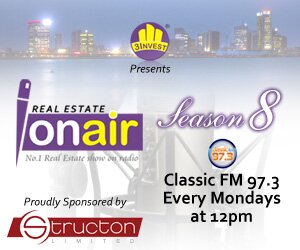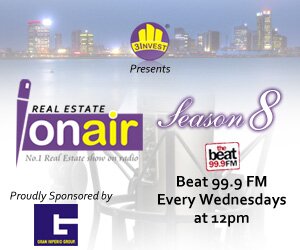Saturday , 8 February 2014
Headlines
- Official Speech of Governor Babatunde Fashola at the launch of Lagos H.O.M.S
- 3INVEST to launch a Mortgage Clinic at PBF in partnership with 2014 Social Media Week
- Lagos State Govt Rolls out Home Ownership Mortgage Scheme
- ECOWAS Leaders Approve $50m for Trans-West African Highway
- CBN bars NMRC from Real Estate Construction Financing
- Real Estate: 3 Things to Note Before you Sign a JV Agreement and 3 Sucessful Real Estate JVs
- 2014 Editor’s Pick: 7 Events That Can Change Your Real Estate Business









Now that we got #NMRC, what are we going to do with it? 10 things to know by 3INVESTONLINE
Before we click glasses in toast to affordable housing and a Fannie Mae-styled mortgage sector, I think Nigeria’s Minister of Finance and coordinating Minister of the economy, Dr. Ngozi Okonjo-Iweala deserves a special mention. She’s such an incurable optimist who exudes a contagious confidence in the plausibility of a healthy mortgage sector; and what it means to the economy.
As a watcher of the developments that heralded the NMRC, my interest has never been in how many houses the scheme will build – and I’m sorry if that startles you. I have always viewed the NMRC in terms the 300, 000 direct jobs it’s designed to create. For me, Nigerians need employments: when wealth is created, housing will take care of itself. I will also not state the obvious that a virile housing finance sector can not erase a humongous 17 million housing deficit over night. But is this a step in the right direction? Oh, absolutely yes!
On January 16, 2014, the launch of the die for Nigeria’s own Fannie Mae was cast. What’s in for the ordinary Nigerian who doesn’t understand the grandiloquent register of housing finance?
1. Reduction in Mortgage Rate: All other things being equal, the greatest news is that the current mortgage rate that fluctuates between 18 and 22% in the country will drop to between 9 -14%. What this mean? More people will be able to access mortgages and pay within a relatively convenient 20-year period.
2. Affordable Housing: It has always been argued that the transactions in Nigeria’s housing sector account for just about 5% of the market potential. That 5% being the luxury-high-to-mid market. But why are developers not building for the remaining 95%? The 95% can’t make effective demand due to high interest rate on mortgages, unemployment and job insecurity. But with the NMRC, a substantial mid-low market, especially those within the 21.3% predicted by the African Development Bank, will hopefully be their own land lords soon.
3. Jobs, Jobs and More Jobs: It is estimated that Nigeria requires an average of 1 million houses annually for the next 17 years to be able to meet its housing needs. However, the NMRC estimates an annual 75, 000 homes with an attendant 30,000 direct and 488,000 indirect jobs after the initial project period. What this mean? Those who can’t afford a lease-to-own house now can afford at least, a decent living. In addition, with the scheme piloting in 14 states of the federation, there will also be an appreciable drop in unemployment-induced crime rate.
What’s in for Nigeria’s Real Estate Industry?
4. A Strengthened Industry: Now that the Primary Mortgage Institutions (PMIs) re-capitalization has been concluded and the NMRC is officially set in motion with an initial $300 million; the real estate industry is anticipated to take an upward swing. One of the objectives of the NMRC is to raise the number of completed mortgages from the current 20,000 housing units to 200,000 units in three years. These will see other sectors such as development, manufacturing, design, services and construction do more businesses in the years ahead, thereby increasing the industry’s contribution to the nation’s economy.
5. An Investor-Friendly Market: If all things work according to plan, it won’t be long before FDIs flood the residential sector like they are currently doing in the commercial space. The ability of the mortgage sector to regenerate more funds from the NMRC pool as they raise mortgages will also excite local investors. The good news is that a 17 million market, with an annual 2.5% population growth rate, is big enough for the share.
6. New Skills, Innovation: This new direction in the market will definitely come with demand for innovations. With agencies such as the DFID Growth and Empowerment in States (GEMS 2) in the equation, one of those will be the much debated alternative building solution. Also, local artisans will be required to step up their games in terms of skill set and delivery, as activities in residential and commercial sector simultaneously will require more efficient way of working. Finally, brokerage and services which are already going digital will require new skill to manage multiple customers with different demands.
What’s in for Nigeria’s economy?
7. Increased GDP: An economy that can create 30,000 jobs annually will definitely not starve of “fertilizer” for growth. The Minister of Finance has always crooned “the economy is doing well”. With more jobs being created through the construction industry, the impact will be felt. Also, the over-flogged news of real estate contributing a paltry 3% to the nation GDP will give way a refreshing new figure.
8. Provision of Housing: In addition, one of the responsibilities of government to provide basic amenities to its citizens will hopefully be realized with an annual estimated housing delivery of 75, 000.
9. Not an Old wine in a New Bottle: Of course, the NMRC is not a perfect scheme; it won’t put roofs over every head – particularly the lower end of the market. However, the NMRC according to the Minister of Finance plans to partner with Real Estate Developers and international Institutions such as IFC to develop a Mass housing rent-to-own scheme which enables Nigerians to own the homes they rent, lower income Nigerians will ultimately own the houses they live in after 15 to 20 years of paying rent. Question the viability and similarity between NMRC and FMBN, The answer is simple. The NMRC is private-sector driven. Parties that are involved include the World Bank, through the International Finance Corporation (IFC) ; the Mortgage Bankers’ Association of Nigeria( MBAN); the Central Bank of Nigeria ( CBN); and of course the Federal Ministry of Finance, besides DFID GEMS 2 and 3. Why can’t the FMBN be empowered to the job? I guess we have to give this scheme the benefit of a doubt. The FMBN is also trying to reinvent itself, perhaps it will complement as Nigeria’s own Freddie Mac.
What’s in for 3Invest?
10.It’s a dream come true: At the Real Estate Unite Conference 2013, Mr. Mustapha Chike-Obi, Managing Director of AMCON said “…the total balance sheet of banks in Nigeria annually is N20 trillion and Nigeria’s annual budget stands at an approximated N5 trillion annually; so where is the money for housing going to come from?”. I have read a few articles in the national dailies reporting this statement without giving credit to WHERE it was made. Those journalistic efforts fail the basic test of reporting – the 5Ws &H. However, for us as an advocacy vanguard, the NMRC is worth all the wines and toasts.
What did I miss? How do you think the NMRC will help you do more business? Leave your thoughts below.
Contact the writer at or follow on twitterRelated posts
Lagos 2014 Budget, Infrastructure and Nigeria’s Real ...
February 2, 2014
Real Estate: 3 Things to Note Before ...
February 2, 2014
Towards a Greener Real Estate, 4 Instant ...
January 12, 2014
IGR revenue report, Lagos No 1 in ...
December 10, 2013
GDP forecasts for four rapid-growth markets in ...
November 5, 2013
Poor policies limit real estate growth– Obih
October 10, 2013